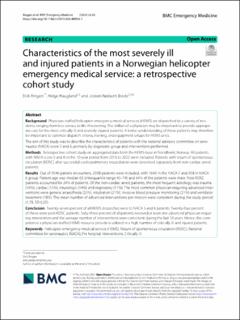| dc.description.abstract | Background
Physician-staffed helicopter emergency medical services (HEMS) are dispatched to a variety of incidents, ranging from less serious to life-threatening. The skillset of a physician may be important to provide appropriate care for the most critically ill and severely injured patients. A better understanding of these patients may therefore be important to optimize dispatch criteria, training, and equipment setups for HEMS units.
The aim of this study was to describe the characteristics of patients with the national advisory committee on aeronautics (NACA) score 5 and 6, primarily by diagnostic group and interventions performed.
Methods
Retrospective cohort study on aggregated data from the HEMS-base in Trondheim, Norway. All patients with NACA score 5 and 6 in the 10-year period from 2013 to 2022 were included. Patients with return of spontaneous circulation (ROSC) after successful cardiopulmonary resuscitation were described separately from non-cardiac arrest patients.
Results
Out of 9546 patient encounters, 2598 patients were included, with 1640 in the NACA 5 and 958 in NACA 6 group. Patient age was median 63 (interquartile range 45–74) and 64% of the patients were male. Post-ROSC patients accounted for 24% of patients. Of the non-cardiac arrest patients, the most frequent aetiology was trauma (16%), cardiac (15%), neurologic (14%) and respiratory (11%). The most common physician-requiring advanced interventions were general anaesthesia (22%), intubation (21%), invasive blood pressure monitoring (21%) and ventilator treatment (18%). The mean number of advanced interventions per mission were consistent during the study period (1,78, SD 0,25).
Conclusion
Twenty-seven percent of all HEMS dispatches were to NACA 5 and 6 patients. Twenty-four percent of these were post-ROSC patients. Sixty-three percent of all patients received at least one advanced physician-requiring intervention and the average number of interventions were consistent during the last 10 years. Hence, the competence a physician-staffed HEMS resource provide is utilized in a high number of critically ill and injured patients. | en_US |

